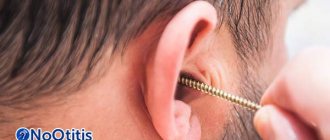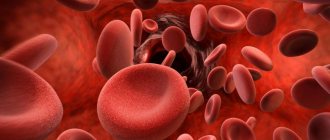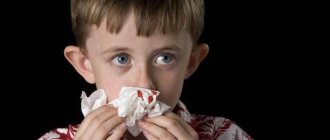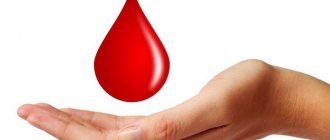Nosebleeds in a child occur not only as a result of injuries, but also often as a result of diseases of various systems and organs; sometimes discovering the original cause is not as easy as it seems at first glance. Diagnosis required.
Which doctor examines such patients? There are several of them.
As a rule, it makes sense to contact an ENT specialist. He is considered the main doctor, this is the problem of his profile.
Also, depending on the origin of the process, consultation with a hematologist, possibly a specialist in problems with the cardiovascular system, is required.
The clinic in the presence of certain diseases is not limited to nosebleeds. Much more often a whole complex of problems is discovered. Symptoms need to be considered systemically.
Treatment is appropriate to the disorder. In addition, it is important to take care to stop the outpouring of liquid connective tissue so as not to provoke complications.
What causes bleeding in children?
The thin mucous membrane of the nasal cavity in children is easily wounded. Bleeding from the nose can be triggered by even a slight impact on it, for example, sharp blowing of the nose or a rinsing procedure. In general, the causes of nosebleeds in children are local and systemic in nature.
Local reasons
Usually they have an external or internal effect on the nasal mucosa:
- Microtraumas of the mucous membrane are the most common phenomenon among children aged 2 to 5 years. Children over 6 years of age may experience more serious nasal injuries, especially during contact sports.
- Overgrowth of adenoids or benign polyps.
- Anomaly in the structure of the nasal septum or the development of the vascular system (dilation of veins and arteries of various locations).
- Chronic runny nose of infectious or allergic nature, sinusitis.
- Dry indoor air, especially in winter when the heating is on. The nasal mucosa dries out, “sticking together” with the capillaries. When you sneeze, the vessel breaks away from the mucous membrane and slight bleeding begins.
- Unregulated use of vasoconstrictor sprays for the common cold.
Occasional nosebleeds with obvious causes are not a serious cause for alarm. You just need to know how to give your baby the help he needs.
Systemic reasons
If a child often has nosebleeds, this means that it is worth going through a medical examination with him. This syndrome may be a manifestation of any pathology. In such cases, they talk about general or systemic causes:
- vasculitis or inflammation of the vascular walls associated with infections;
- deficiency of vitamin C, it is in particular responsible for the strength of the vascular wall; with its deficiency, the vessels become fragile and bleeding occurs;
- hemophilia, in which it is very difficult to stop any bleeding;
- rises in pressure (provoke bleeding of blood vessels in the back of the nose);
- heart pathologies;
- periods of hormonal changes.
Guys who play sports may bleed after heavy physical exertion. What frightens parents the most is if their children periodically bleed from the nose while sleeping. Sometimes, to prevent such a syndrome, it is enough to organize normal humidity in the child’s bedroom.
Causes and mechanisms
There is certainly a connection between fever and nosebleeds. When thermal production increases, the body needs to release excess heat. And one of the main mechanisms ensuring this process is the expansion of peripheral vessels located in the skin and mucous membranes. If the capillary wall is damaged in some way or is very weak, it may burst. This is why a child with a fever bleeds from the nose. And there are many diseases that cause high fever. Most of them are infections:
- Respiratory (flu and ARVI, pneumonia).
- "Children's" (scarlet fever, measles, rubella).
- Intestinal (salmonellosis, dysentery).
- Neurological (meningitis).
A special group consists of viral diseases of the upper respiratory tract. The pathogen affects the epithelium of the nasal cavity and vascular endothelium, and the toxic effect on the body is accompanied by a temperature reaction. Collectively, this becomes a source of bleeding. But hyperthermia sometimes has a non-infectious nature - for example, when the body overheats (heat or sunstroke).
We should not forget about the factors that contribute to the thinning of the vascular wall, reducing its resistance and affecting the blood coagulation system. These include the following conditions:
- Nutritional disorders (hypo- and avitaminosis C, P, E).
- Vasopathies (Rendu-Osler disease).
- Thrombocytopenic purpura.
- Coagulopathies (hemophilia).
Capillaries can burst under the influence of increased pressure - during physical activity or arterial hypertension. Dry and polluted air, as well as the inflammatory process – rhinitis, have a damaging effect on the mucous membrane. Often it occurs in isolation, not being part of the structure of respiratory infections. At the same time, some children may experience nosebleeds, especially with excessive nose blowing. Among the local processes it is also worth noting:
- Nose injuries.
- Deviation of the nasal septum.
- Tumor diseases (angioma).
It is difficult to associate them with fever, but the isolated course of several diseases in a child cannot be ruled out. Then even a temperature of 37 degrees can be combined with nosebleeds. Based on the above, the question of the combination of two symptoms is not as simple as we would like. And only a specialist who has carried out differential diagnostics can answer it.
To tell why a child’s nose is bleeding at fever, you must first consult a doctor. And he will already conduct further research.
Each condition has its own clinical picture that needs to be identified. Therefore, the doctor interviews the patient and the child’s parents about complaints, conducts an examination, and, if necessary, uses other methods of physical examination (palpation, percussion, auscultation). In general, children are very sensitive to high temperatures, especially at an early age. Due to intoxication, even convulsions (febrile), vomiting and diarrhea, and meningism may occur. And at an older age, nosebleeds are not uncommon.
Respiratory infections
In respiratory diseases, fever is a very characteristic symptom. It is the result of exposure to toxins and the virus itself on the body, and also reflects the intensity of immune reactions aimed at combating them. A child's nose often bleeds when they have the flu. The fact is that the causative agent of the disease has a tropism not only for the epithelium of the upper parts of the respiratory tract, but also affects the wall of blood vessels, forming pores in it. Capillaries become brittle and burst easily when the temperature rises.
Flu is transmitted by airborne droplets. It develops during the epidemic season (winter-spring) and begins acutely. The symptoms of the disease are quite characteristic:
- Fever (38–40 degrees).
- Puffiness of the face.
- Redness of the sclera.
- Nasal congestion.
- Sore throat.
- Dry cough.
- Body aches.
- Malaise.
Typically, a respiratory infection occurs in mild or moderate forms. But sometimes the flu is characterized by severity and is accompanied by complications (drop in blood pressure, pneumonia, pulmonary edema).
Acute rhinitis
Isolated runny nose is also a very common phenomenon, occurring in patients of any age. Acute inflammation of the nasal mucosa occurs in several stages. First, the epithelium is irritated by pathogens (bacteria, viruses) or other factors (cold, dust). At this stage, dryness and tickling in the nose are felt. There is no swelling or discharge yet. But the temperature rises and nosebleeds may appear. I am worried about malaise, in some cases lacrimation and conjunctivitis develop.
The next stage of rhinitis is serous discharge. Instead of dryness, the mucous membrane begins to intensively produce liquid secretions. Severe rhinorrhea appears, due to swelling, nasal breathing becomes more and more difficult, and the sense of smell decreases. Then comes the stage of transformation of the discharge into mucopurulent. Nasal breathing gradually improves, fever subsides, and general condition is restored. The pathology lasts about a week.
Even a common runny nose can cause nosebleeds in a child. However, it often develops in the presence of additional factors that worsen the condition of the vascular wall.
Thrombocytopenic purpura
Increased bleeding is the main symptom of diseases with impaired blood clotting properties. The first stage of hemostasis (vascular-platelet) can be disrupted when antibodies to blood platelets accumulate in the body or there are structural disturbances in them. This is how Werlhof's disease or thrombocytopenic purpura develops. In childhood, pathology often occurs in an acute form, occurring after viral infections or vaccination. The child suddenly develops signs of hemorrhagic syndrome:
- Bleeding from the nose, teeth.
- Skin hemorrhages (bruise type).
- Pallor.
- Pressure drop.
- Dizziness.
Fever occurs (up to 38 degrees), general malaise worries, and in many children the lymph nodes become enlarged. The acute form often ends in spontaneous recovery. In some cases, the disease is not even detected because it is mild.
Are nosebleeds related to age?
The causes of nosebleeds in children are associated not so much with age as with their increasing activity and hormonal changes. Why does nosebleed occur in children aged 1 to 7 years? What happens in the teenage body?
Preschool age
As the baby approaches one year of age, he learns to walk and explores the world around him. Falls are inevitable, which can injure your nose. Therefore, random nosebleeds in a one-year-old child are not a reason to panic. To minimize the risk of minor injuries, you need to create a safe environment for him.
As they get older, at 3-4 years old, children begin to communicate with each other, they play outdoor games, during which minor injuries are also possible, resulting in bleeding from the nose. In kindergarten, the child comes into contact with other children, including sick ones.
Children are great experimenters. This circumstance obliges parents to be more attentive to children's games, especially when the baby is only 1-2 years old. The cause of a nosebleed is a small part of a toy, a bead, or any small object that a child accidentally or intentionally puts in the nose.
Children two to three years old pick their nose unconsciously. After treating a runny nose with vasoconstrictors, crusts of dried mucus form on the inner surface of the nose, which interfere with free breathing. And children try to get rid of them in this way.
In children under 3 years of age, the thermoregulation system is immature, and the work of their blood vessels is related to this. It is for this reason that it is dangerous for children to remain in the sun or in a stuffy enclosed space (for example, in a car) for a long time. The baby's body tries to get rid of overheating through nosebleeds.
Puberty
This is a period in the life of children when patience and increased attention to their health are required from adults. Puberty for girls begins at 9-10 years old, for boys a little later - at 11 years old. Under the influence of hormones in adolescents, vascular tone changes, and instability of their nervous regulation is observed. During the formation of the cycle, girls often experience nosebleeds during menstruation.
The hormonal “explosion” in adolescence causes high blood pressure. Bleeding from the nose at such moments saves the child from the more serious consequences of increased blood pressure.
Body examination
If bleeding began as a result of injury or the insertion of a foreign object into the nose, take the patient to a traumatologist. Diagnostics will proceed as follows:
- The doctor will examine the nose manually and using a rhinoscope.
- He will send you for an x-ray of the skull.
- In case of a complex fracture, a CT or MRI of the nose and skull may be needed.
If bleeding occurs spontaneously and regularly, contact your pediatrician. First of all, the doctor will measure your blood pressure, collect data on previous diseases and current symptoms. He will also refer you for a general blood test.
During the initial examination, sometimes it is already possible to accurately determine the cause of nosebleeds or to suspect a possible cause. If all tests during the initial examination are normal and there are no complaints, then perhaps the cause is external (for example, low air humidity).
Depending on the results of the initial examination, the following diagnostic procedures may be prescribed.
| Suspected Cause | Diagnostic methods |
| Diseases of the nose | ENT consultation, X-ray of the nose and paranasal sinuses, MRI of the paranasal sinuses. |
| Hypertension | 24-hour blood pressure monitoring, kidney examination (kidney ultrasound, urine test, blood test for urea, creatinine, residual nitrogen). |
| Increased intracranial pressure | Consultation with a neurologist, fundus examination, MRI of the brain, duplex scanning of the brachiocephalic arteries. |
| Hypo- or vitamin deficiency | Blood test for certain vitamins. Sometimes a lack of vitamins is visible even without a targeted analysis of the vitamin content in the blood. |
| Allergy | Consultation with an allergist or immunologist, blood test for immunoglobulins E (IgE), allergy tests for various allergens. |
| Blood clotting disorders | Consultation with a hematologist, coagulogram (test for blood clotting). |
| Hormonal disorders | Consultation with an endocrinologist, blood test for thyroid hormones, sex hormones. |
| Liver diseases | Ultrasound of the liver, blood test for bilirubin, aminotransferases (ALAT and AST). |
| Heart failure | ECG, cardiac ultrasound (EchoCG), stress echoCG, Holter monitoring. |
| Leukemia | Consultation with a hematologist or hematologist-oncologist, biochemical blood test (for lactate dehydrogenase, AST, urea, bilirubin, fibrinogen, total protein, glucose), myelogram (analysis of bone marrow punctate), cytochemical study of bone marrow punctate. |
Rhinoscope is a device designed for visual examination of the nasal cavity.
Why are nosebleeds dangerous?
Epistaxis (as the flow of blood from the nose is called in medicine) can vary in intensity and duration. Blood may come from one nostril or both. Sometimes it flows out slowly, in drops, and sometimes it flows in a stream. When a child’s nose bleeds slightly from one nostril and stops spontaneously, this indicates damage to a small vessel.
Help is required if the blood flows in a stream and does not stop for a long time. Severe bleeding, even as a result of a minor injury, may indicate the presence of some pathology, for example, a blood clotting disorder.
Frequent nosebleeds in children cannot be ignored for the following reasons:
- If a child constantly bleeds from the nose, even a little at a time, then blood loss accumulates, ultimately leading to anemia. He becomes lethargic, gets sick often, and his immunity decreases. In addition, due to a decrease in hemoglobin, tissue nutrition and oxygen supply deteriorate. As a result, pathologies of various organs develop.
- If frequent bleeding is caused by drying out the mucous membrane with dry air or due to the use of sprays, this can lead to degenerative changes and result in thinning and fragility of the blood vessels.
- Large blood losses for young children are dangerous because hemorrhagic shock can develop.
If a child has posterior nosebleeds , this is a reason to call an ambulance and take him to the hospital. In this case, blood from the nostrils may not flow, but flow down the back wall of the nasopharynx directly into the esophagus or into the trachea. This condition has pronounced symptoms:
- cardiopalmus;
- increasing difficulty breathing;
- constant thirst;
- noise in ears;
- Coughing or vomiting blood may occur.
Such conditions are rare for children, but parents need to know about them, especially if the baby has chronic cardiovascular diseases. The danger of posterior bleeding also lies in the fact that it is impossible to visually assess the amount of blood lost.
How to stop bleeding?
- Calm the child and make him spit out blood. It should not get into the throat and cause nausea.
- Place the child on your lap so that his head is tilted slightly down. Press the napkin to the spout and secure it with your hand. You need to wait about 10 minutes without removing the napkin.
- If the child is quite old, you need to ask him to breathe through his mouth. In order for him not to be scared or bored, you can read a book or turn on a cartoon.
- After 10 minutes, check to see if the bleeding has stopped. If not, you need to put a cold compress on the bridge of your nose and cover your nose with a napkin again for 10 minutes.
- If the bleeding does not stop, you should definitely consult a doctor.
What not to do!
Do not allow the child to take a horizontal position or tilt his head back. This will cause blood to leak into the throat. Do not plug your nostrils with cotton swabs. They can stop the bleeding, but during removal they will again damage the mucous membrane and the problem will recur.
When should you see a doctor?
Does your child's nose often bleed? This is a reason to contact an otolaryngologist. Even if the epistaxis is short-term and not abundant. During the examination, the doctor examines the condition of the mucous membrane. Upon examination you may find:
- erosion (it is usually cauterized to prevent recurrent bleeding);
- the presence of swelling and areas of atrophy;
- foreign object injuring the mucous membrane;
- abnormalities in the structure of the nasal septum.
Based on the detected problem, the doctor prescribes treatment. If there are no local causes of frequent nosebleeds in a child, he is referred for consultation to a pediatrician and specialized specialists - a cardiologist, neurologist, hematologist or endocrinologist. Examinations of the kidneys, cardiovascular system and other organs are carried out, pathologies of which can provoke nosebleeds.
Other reasons
In addition to the fact that antibodies produced at elevated body temperatures disrupt the functioning of the circulatory system, there may be other factors that cause epistaxis. They are divided into local and general. Let's take a closer look at each group.
- Infectious lesions that cause general intoxication, such as influenza, scarlet fever, measles, diphtheria, etc.
- Severe disturbances in the functioning of the circulatory system, which include leukemia, immune hemopathy, hemorrhagic diathesis, anemia.
- Vitamin deficiency - a lack of vitamins A, E and C negatively affects the strength of the walls of blood vessels and the functioning of the circulatory system.
- Rendu-Osler disease. This is a pathology that is inherited; it causes abnormalities in the development of blood vessels, their walls become less dense and prone to bleeding.
- Pathologies of the heart muscle, lungs, liver and kidneys.
- Increased pressure, during fever it becomes even higher, as the mucous membranes swell due to the dilation of blood vessels and capillaries.
- Disruption of the menstrual cycle, it most often worries girls who have just started menstruation and have not yet stabilized the cycle itself.
- Dry inhaled air. As body temperature rises, the nasal mucosa becomes dry and depleted; this process can be aggravated by inhaling insufficiently humidified air.
- Coughing. With physical strain, which is created during coughing, the pressure can rise sharply, which leads to rupture of capillaries and blood vessels.
- Injuries. Crusts form on the overdried mucous membrane, which children pick off. Since their vessels are located on the surface, this act can cause epistaxis.
- Tumors in blood vessels. Hymangiomas can also provoke bleeding during fever; they make the vessels too vulnerable and fragile.
- Rhinitis. When the mucous membrane swells, the vessels swell, which can lead to sudden leakage of blood from the nose.
- Anatomical features of the structure of the nasal septum. The curvature of this part of the nose can negatively affect the functioning of the mucous membrane; it loses its protective functions and cannot fully protect the vessels from rupture.
When is emergency help required?
What to do if a child has a nosebleed and it cannot be stopped? Emergency medical attention required. It will also be needed in the following cases:
- if blood loss is accompanied by dizziness or fainting;
- the child has been diagnosed with hemophilia;
- there was a head injury the day before (especially if clear fluid comes out of the nose with blood);
- if there is vomiting of blood;
- if blood loss is 200 ml or more;
- there is renal or cardiovascular pathology.
An ambulance will also be needed if a child’s nose bleeds due to a rise in temperature during a severe viral infection. A dangerous symptom is bleeding from both nostrils at the same time.
First aid for nosebleeds
When the bleeding does not stop spontaneously, the child needs help:
- He needs to be calmed and seated, tilting his body forward.
- Pressing your nostrils with your fingers is a mechanical stop of blood. You can insert a thick cotton swab soaked in 3% hydrogen peroxide into the nostril. It takes 5-10 minutes for a clot to form.
- Make a cold lotion or apply a piece of ice to the back of your nose, wrapping it in a plastic bag. The cold will have a vasoconstrictor effect and stop the bleeding. At the same time, it is good to put a heating pad on your feet. The heat will divert blood from the vessels of the nose, reduce the pressure in them and make the bleeding less profuse or stop it altogether.
If the bleeding does not stop, it is better to place a container under it. This will help determine the amount of blood loss.
Correct baby position to stop nosebleeds
These measures are usually sufficient to control minor bleeding. But in any case, at this time it is necessary to monitor the child’s breathing, pulse and general condition.
What should you not do if you have a nosebleed?
Absolutely forbidden:
- Lay the baby down, especially so that the head is below the level of the legs;
- throw your head back, in which case blood will flow into your throat;
- trying to blow the child's nose;
- remove the object from the nose yourself if it turns out to be the cause of nosebleeds.
These actions will make the situation worse and may increase bleeding.
Non-dangerous nosebleeds are easy to prevent. To do this, it is enough to eliminate the provoking factors. Parents should provide their child with normal air humidity, teach him to blow his nose correctly and wean him from picking his nose. And also, if possible, prevent small objects from getting into the rivers. In short, create a healthy and safe living environment for the baby.
Complications
With heavy nosebleeds, hemorrhagic shock may develop:
- a sharp decrease in blood pressure as a result of large blood loss;
- confusion or loss of consciousness;
- tachycardia;
- pronounced pallor of the skin;
- weak thready pulse.
To objectively assess the child’s condition after blood loss, it is necessary to do a general blood test and a coagulogram.
Frequently recurring nosebleeds can lead to serious consequences:
- general exhaustion of the body;
- development of anemia;
- decreased immunity.
Chronic oxygen starvation in the case of nosebleeds leads to disruption of the functioning of various organs, as well as to the development of irreversible pathological changes in their structure.
If such health problems are ignored, death can occur.











